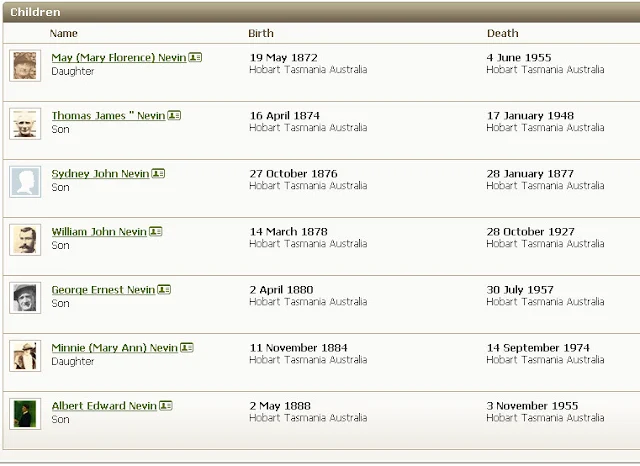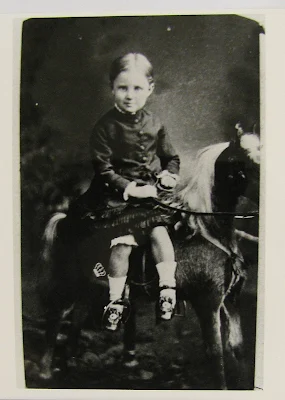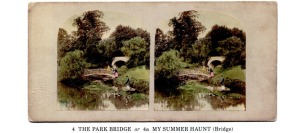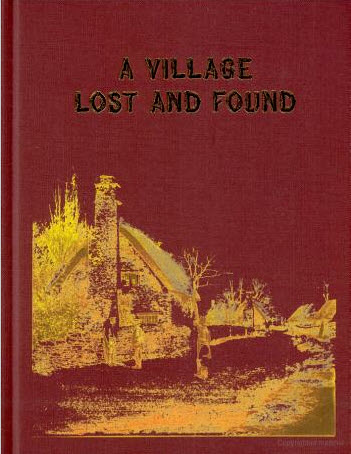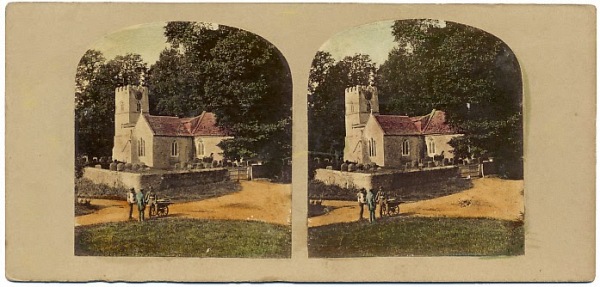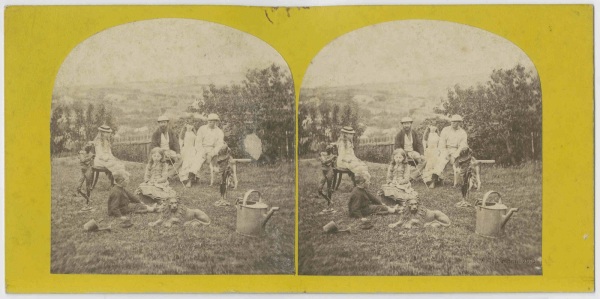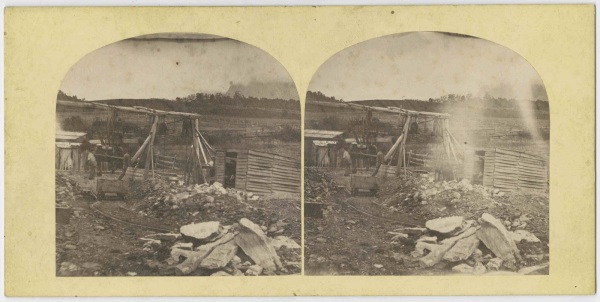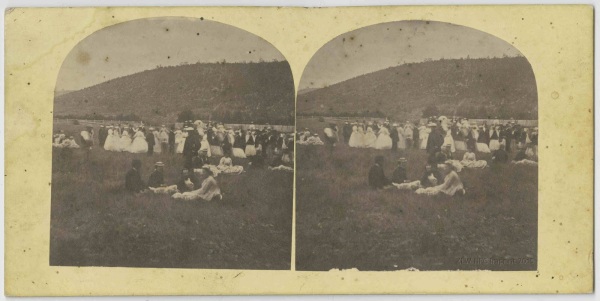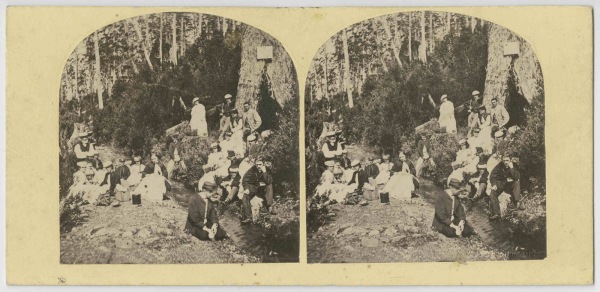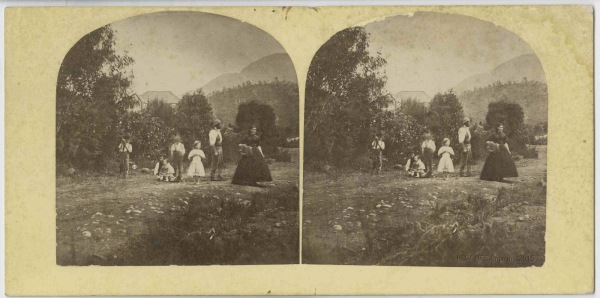These stereographs taken by Thomas J. Nevin and stamped recto with his blindstamp impress - "T. NEVIN PHOTO" - over a decade in the 1860s-1870s are held in the Tasmanian Museum and Art Gallery collections.
T. J. Nevin's studio, 140 Elizabeth Street Hobart TownThis is one of two different views of Thomas Nevin's studio and shop, extreme right of frame, situated at 140 Elizabeth St. Hobart, three doors from Patrick Street, next door to the Standard Hotel at 142 Elizabeth Street on the corner.

Above: a view of Thomas Nevin's studio and shop, extreme right of frame, operating as the City Photographic Establishment, 140 Elizabeth St. Hobart, Tasmania.
Stereograph by T. J. Nevin ca. 1867-70
The dark building next door at 138 Elizabeth St., Nevin's residence, was leased from A. E. Biggs
"T. NEVIN PHOTO" blindstamp impress on lower centre of mount. Verso blank.
The Tasmanian Museum and Art Gallery Collection TMAG Ref: Q1994.56.12
The Trip to Adventure Bay 1872
Copies of this series were collected by Jean Porthouse Graves, daughter of solicitor and townsman John Woodcock Graves the younger, the organizer of this VIP trip to Adventure Bay, 31 January 1872. Thomas J Nevin was commissioned to produce a series of group photographs for the visitors which he also advertised for sale in the press the following week.
These copies are held at the Tasmanian Museum and Art Gallery. This group portrait of the VIPs on board the
City of Hobart was especially commissioned. It not only carries Nevin's blindstamp on the mount at right, it is also stamped verso with his government contractor stamp.

Above: stereograph, group portrait of the VIPS by T. J. Nevin
Day-trippers to Adventure Bay on board the
City of Hobart 31st January 1872
"T. NEVIN PHOTO" blindstamp impress recto on right hand side
Verso with T. J. Nevin’s government contractor’s stamp with Royal Arms insignia.
Tasmanian Museum and Art Gallery Collection Ref: Q1994.56.2

Above: verso of stereograph of the group portrait of VIPS by T. J. Nevin
Day-trippers to Adventure Bay on board the City of Hobart 31st January 1872
"T. NEVIN PHOTO" blindstamp impress recto on right hand side
Verso shows T. J. Nevin’s government contractor’s stamp with Royal Arms insignia.
Tasmanian Museum and Art Gallery Collection Ref: Q1994.56.2.backed.
Below: another configuration with more members of the VIP group at Adventure Bay, 31st January 1872. The man laughing, sitting between the Hon. Alfred Kennerley (lower left) and Sir John O'Shanassy, is Hugh Munro Hull, Parliamentary librarian. He seems to have appreciated comments coming from Thomas Nevin at the point of capture, while Sir John O'Shanassy (with stick), reads on, oblivious. The figure running into the scene at centre is John Woodcock Graves (the younger), organiser of the excursion.

Nevin's blindstamp impress "T. NEVIN PHOTO" is on the mount at centre.
This stereo is badly water-damaged.
It is held at the Tasmanian Museum and Art Gallery, Ref: Q1994.56.24.
Photo taken at TMAG 10th November 2014
Photo copyright © KLW NFC 2014 ARR
TMAG Ref: Q1994.56.24
This group photograph (below) of the colonists at Adventure Bay, 31st January 1872, show men of premier social status dressed in full Victorian attire from head to toe photographed in reclining and recumbent poses. These captures by Thomas Nevin of Sir John O'Shanassy and Sir James Erskine Calder lolling about in bush surroundings are quite remarkable.

Above: another group photograph of the colonists at Adventure Bay 31st January 1872
Figures on lower left, recumbent: John Woodcock Graves jnr and Sir John O'Shanassy
Between them: John Graves' teenage daughter, Jean Porthouse Graves
Above her in topper: Robert Byron Miller (whose son Francis Knowles Miller she married in 1885)
On right: sitting with stick, Hon. Alfred Kennerley, Mayor of Hobart.
Head in topper only on extreme right: Sir James Erskine Calder.
Stereograph in double oval buff mount with "T. NEVIN PHOTO" blindstamp impress in centre
Verso is blank.
Photo taken at TMAG 10th November 2014
Photo copyright © KLW NFC 2014 ARR
Tasmanian Museum and Art Gallery Collection Ref: Q1994.56.5
Along the River Derwent
These stereographs were printed in commercial numbers by both Thomas J. Nevin and his friend and colleague, Samuel Clifford for the tourist trade.

TMAG Catalogue notes (online until 2006)
Ref: Q1994.56.21
ITEM NAME: Photograph:
MEDIUM: sepia stereoscope salt paper print
MAKER: T Nevin [Artist]
DATE: 1870s
DESCRIPTION : Scene near New Norfolk ?
INSCRIPTIONS & MARKS:
Impressed on front: T Nevin/ photo
Tasmanian Museum and Art Gallery Collection Ref: Q1994.56.21

TMAG Catalogue notes (online until 2006)
Ref: Q1994.56.7
ITEM NAME: Photograph:
MEDIUM: sepia stereoscope salt paper print
MAKER: T Nevin [Artist]
DATE: 1870c
DESCRIPTION : Salmon Ponds at Plenty near New Norfolk
INSCRIPTIONS & MARKS:
Impressed on front: T Nevin/ photo
Tasmanian Museum and Art Gallery Collection Ref: Q1994.56.7
 Ferns, ferns and more ferns
Ferns, ferns and more ferns
At least five stereographs of ferns by Thomas J. Nevin are held at the Tasmanian Museum and Art Gallery, dated to ca. 1870. Prints of these stereographs were produced by the hundreds; some were imprinted recto with his blindstamp "T. NEVIN PHOTO", others of the same image were left blank. T:

FERNS: T. Nevin impress "T. NEVIN PHOTO" on left side mount
TMAG Ref: Q1994.56.13

FERNS: TMAG Ref: Q16826.34

FERNS: TMAG Ref: Q16826.30.1.backed
Verso inscription: " Ferns Kangaroo Valley"

FERNS: TMAG Ref: Q16826.30.1

FERNS. One of many stereographs by Thomas J. Nevin showing ferns in summer and winter around the foothills and valleys of kunanyi/Mt Wellington
Stereograph on arched buff mount ca. 1868
Tasmanian Museum and Art Gallery Collection TMAG Ref: Q16826-31-1

FERNS: TMAG Ref: Q16826.31.2

The blindstamp:
T. NEVIN
PHOTO
Charles Darwin on Tasmanian FernsIn this extract from his journal, Charles Darwin expressed amazement at the Tasmanian ferns he encountered on his walk around Mount Wellington:
From Chapter XIX:
Extract from Charles Darwin's account of his visit to Hobart, February 1836 aboard the
Beagle.
Journal of researches into the geology and natural history of the various countries visited by H.M.S. Beagle. (London : H. Colburn, 1839.)
"The Beagle stayed here ten days, and in this time I made several pleasant little excursions, chiefly with the object of examining the geological structure of the immediate neighbourhood.
The main points of interest consist, first in some highly fossiliferous strata, belonging to the Devonian or Carboniferous period; secondly, in proofs of a late small rise of the land; and lastly, in a solitary and superficial patch of yellowish limestone or travertin, which contains numerous impressions of leaves of trees, together with land-shells, not now existing. It is not improbable that this one small quarry includes the only remaining record of the vegetation of Van Diemen's Land during one former epoch.
The climate here is damper than in New South Wales, and hence the land is more fertile. Agriculture flourishes; the cultivated fields look well, and the gardens abound with thriving vegetables and fruit-trees. Some of the farmhouses, situated in retired spots, had a very attractive appearance. The general aspect of the vegetation is similar to that of Australia; perhaps it is a little more green and cheerful; and the pasture between the trees rather more abundant.
One day I took a long walk on the side of the bay opposite to the town: I crossed in a steamboat, two of which are constantly plying backwards and forwards. The machinery of one of these vessels was entirely manufactured in this colony, which, from its very foundation, then numbered only three and thirty years! Another day I ascended Mount Wellington; I took with me a guide, for I failed in a first attempt, from the thickness of the wood. Our guide, however, was a stupid fellow, and conducted us to the southern and damp side of the mountain, where the vegetation was very luxuriant; and where the labour of the ascent, from the number of rotten trunks, was almost as great as on a mountain in Tierra del Fuego or in Chiloe. It cost us five and a half hours of hard climbing before we reached the summit. In many parts the Eucalypti grew to a great size, and composed a noble forest.
In some of the dampest ravines, tree- ferns flourished in an extraordinary manner; I saw one which must have been at least twenty feet high to the base of the fronds, and was in girth exactly six feet. The fronds forming the most elegant parasols, produced a gloomy shade, like that of the first hour of the night.
The summit of the mountain is broad and flat, and is composed of huge angular masses of naked greenstone. Its elevation is 3100 feet above the level of the sea. The day was splendidly clear, and we enjoyed a most extensive view; to the north, the country appeared a mass of wooded mountains, of about the same height with that on which we were standing, and with an equally tame outline: to the south the broken land and water, forming many intricate bays, was mapped with clearness before us. After staying some hours on the summit, we found a better way to descend, but did not reach the Beagle till eight o'clock, after a severe day's work. (Feb. 6, 1836: pp 486-7) "
[end of extract]
Darwin's astonishment at the magnificence of these ferns was repeated by Tasmanian photographers right through to the 1900s in endless variations. Ferns laden with snow was a particularly popular image. The
State Library of Tasmania holds hundreds of photos taken by Clifford, Anson, Cawston, Abbott, Allport, Haigh, Winter, Baily and every other photographer between 1860-1880.
RELATED ARTICLES main weblog
Public Collections
Private Collections




